Poppies
by Claude Monet
Fast Facts
- Year
- 1873
- Medium
- Oil on canvas
- Dimensions
- 50.0 × 65.3 cm
- Location
- Musée d’Orsay, Paris
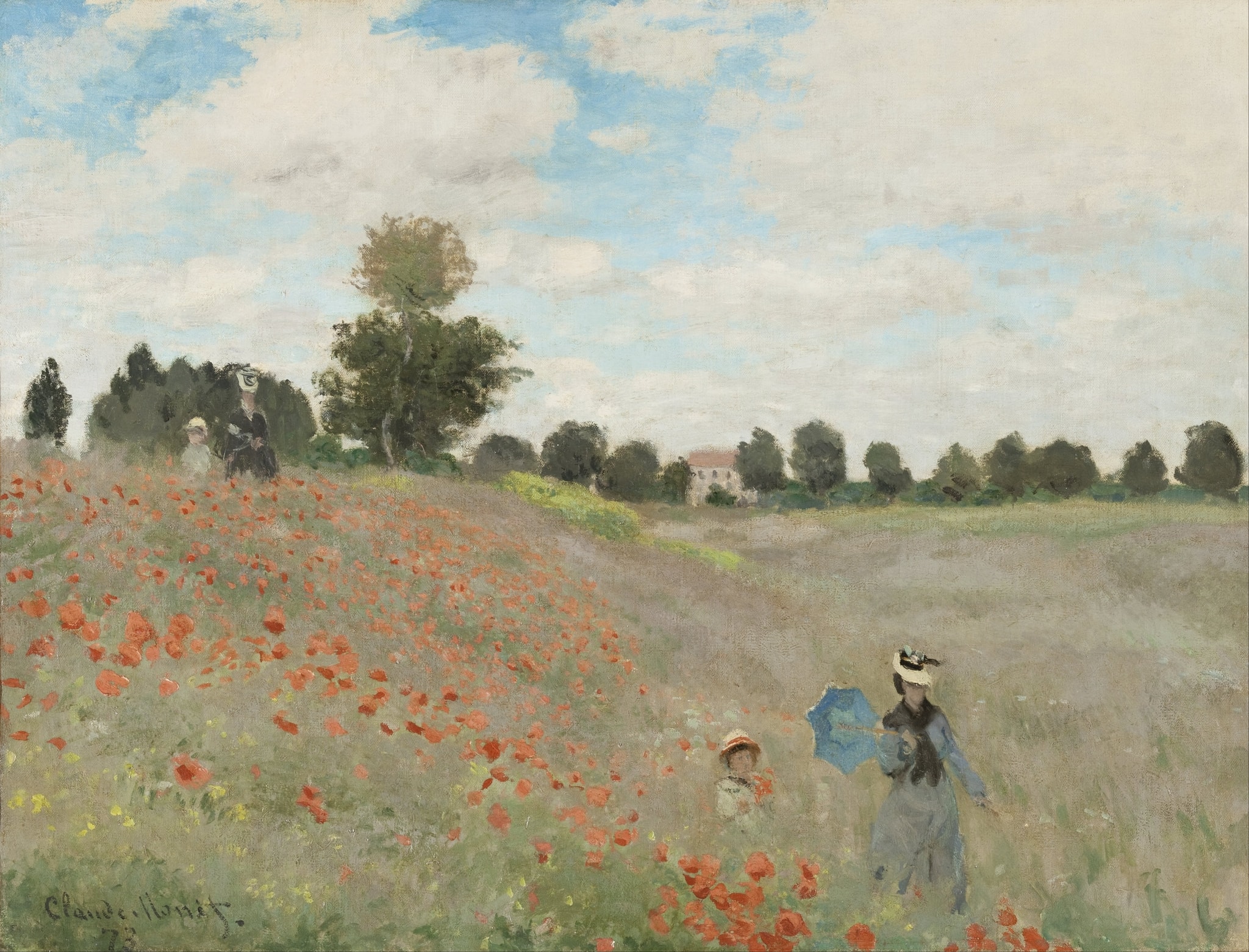
Click on any numbered symbol to learn more about its meaning
Meaning & Symbolism
The meaning of Poppies lies in its claim that perception—shifting light, moving air, passing moments—is the true content of modern life. Monet converts a walk near Argenteuil into an optical meditation, using doubled figures and color zones to visualize time unfolding in place 1. It matters because the canvas publicly models the Impressionist program at the dawn of the movement, privileging immediate experience over stable narrative and helping define what a modern picture could be 2. By making the field’s red rhythm speak louder than line, Monet advances a language edging toward abstraction within everyday subject matter 1.
Monet organizes the scene along a firm oblique that runs from the lower left, where scarlet blooms are rendered as brisk dabs, up toward the central tree and the distant house half-veiled by a windbreak. This diagonal is not merely scenic; it is the armature that lets sensation read as structure. The mother-and-child pair in the foreground—she lifting a blue parasol that flashes cool against the red field—reappears higher on the slope, smaller and slightly dimmer, like a second beat in the same measure. Rather than narrating two different people, the repetition acts as a visual time lapse, a way to picture successive instants without resorting to story. Orsay’s curators identify this doubling as the device that divides the canvas into two chromatic zones—red versus bluish‑green—so that color does the compositional work usually assigned to contour 1. The result is a field that reads as movement: poppies flicker, grasses lean, and clouds travel in pale blocks across a sky broken into cool patches. This construction asserts a thesis about modern seeing. In Argenteuil—a rail-linked suburb where city dwellers strolled and idled—Monet treats leisure not as anecdote but as the condition that allows plein‑air perception to be primary. The parasol is functional and iconographic: a bourgeois accessory that marks outdoor recreation and, crucially, a tool for testing how hue, shadow, and wind register on cloth and skin, a logic Monet also pursued in Woman with a Parasol (1875) 3. The figures become “pretexts,” in the Orsay’s phrase, inserted to articulate the diagonal and to punctuate the red-green counterpoint; their faces are abbreviated, their identities secondary to how they modulate scale and color across space 1. This prioritization of optical effect over finish—those “blobs” of paint that stand in for flowers and the soft-edged tree line—signals a deliberate advance toward abstraction inside a still-legible landscape 1. Seen this way, the painting’s power is not pastoral calm but a disciplined claim about what painting can measure: the simultaneity of place and moment. Poppies also reframes nature as modern subject. As Robert Herbert has argued, Impressionism’s embrace of suburban leisure was inseparable from the new social rhythms of Paris and its environs; scenes like this are modern not because of factories or boulevards, but because of the habits they picture—day trips, strolling, time spent looking 4. Monet aligns with that history while resisting sentimentality: the farmhouse sits back, a tonal anchor, but the eye returns to the field’s red cadence, which reads as seasonal intensity rather than emblem. Importantly, the poppies do not invoke later remembrance symbolism tied to World War I; in 1873 they operate as chromatic markers and summer’s sign, decades before the flower’s memorial associations emerged 5. That historical precision matters for why Poppies is important: it documents an artist using the ordinary to test a new pictorial order at the moment Impressionism stepped into public view—the first independent exhibition in 1874 included this canvas—declaring that modern meaning could be made from the experience of light itself 2.Citations
- Musée d’Orsay, Coquelicots (object page and curatorial analysis)
- Musée d’Orsay, Paris 1874: Inventing Impressionism (exhibition site)
- National Gallery of Art (Washington), Woman with a Parasol—Madame Monet and Her Son
- Robert L. Herbert, Impressionism: Art, Leisure, and Parisian Society (Yale University Press)
- Royal British Legion, ‘In Flanders Fields’ and the poppy as remembrance
- Musée d’Orsay, Coquelicots (object page and curatorial text)
- T. J. Clark, The Painting of Modern Life (book overview)
- Artnet News, 2024 Orsay protest incident (museum reported no damage)
Explore Deeper with AI
Ask questions about Poppies
Popular questions:
Powered by AI • Get instant insights about this artwork
Interpretations
Historical Context
Source: Musée d’Orsay; Robert L. Herbert
Formal Analysis
Source: Musée d’Orsay
Social Commentary
Source: Robert L. Herbert; T. J. Clark
Symbolic Reading
Source: Musée d’Orsay; National Gallery of Art (Washington); Royal British Legion
Reception History
Source: Musée d’Orsay; Artnet (reporting museum statements)
Related Themes
About Claude Monet
More by Claude Monet

Haystacks Series by Claude Monet | Light, Time & Atmosphere
Claude Monet
Claude Monet’s <strong>Haystacks Series</strong> transforms a routine rural subject into an inquiry into <strong>light, time, and perception</strong>. In this sunset view, the stacks swell at the left while the sun burns through the gap, making the field shimmer with <strong>apricot, lilac, and blue</strong> vibrations.

The Artist's Garden at Giverny
Claude Monet (1900)
In The Artist's Garden at Giverny, Claude Monet turns his cultivated Clos Normand into a field of living color, where bands of violet <strong>irises</strong> surge toward a narrow, rose‑colored path. Broken, flickering strokes let greens, purples, and pinks mix optically so that light seems to tremble across the scene, while lilac‑toned tree trunks rhythmically guide the gaze inward <sup>[1]</sup><sup>[3]</sup>.
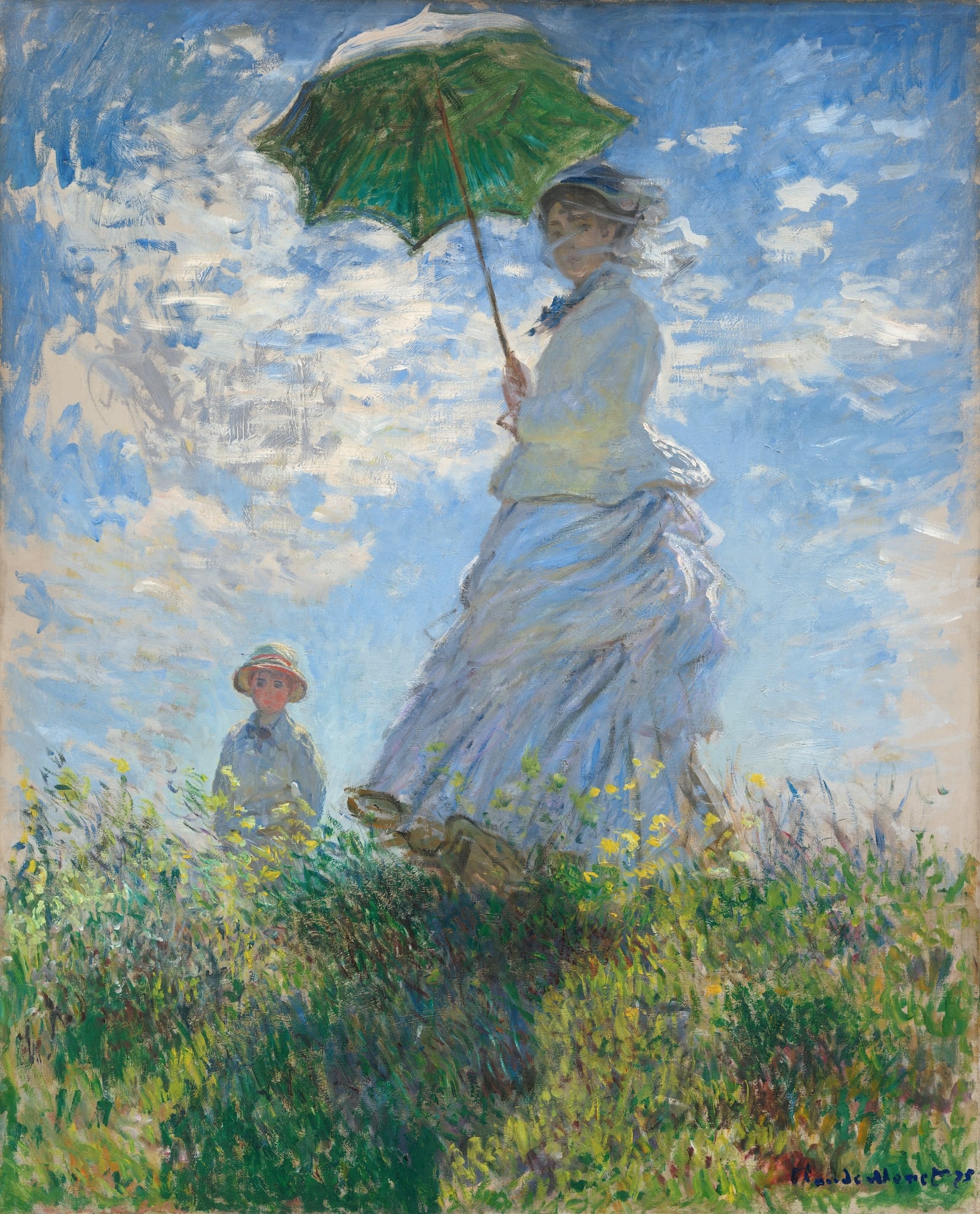
Woman with a Parasol
Claude Monet (1875)
Claude Monet’s Woman with a Parasol fixes a breezy hillside instant in high, shifting light, setting a figure beneath a <strong>green parasol</strong> against a vast, vibrating sky. The low vantage and <strong>broken brushwork</strong> merge dress, clouds, and grasses into one atmosphere, while a child at the rise anchors depth and intimacy <sup>[1]</sup>. It is a manifesto of <strong>plein-air</strong> perception—painting the sensation of air in motion rather than the contours of things <sup>[2]</sup>.
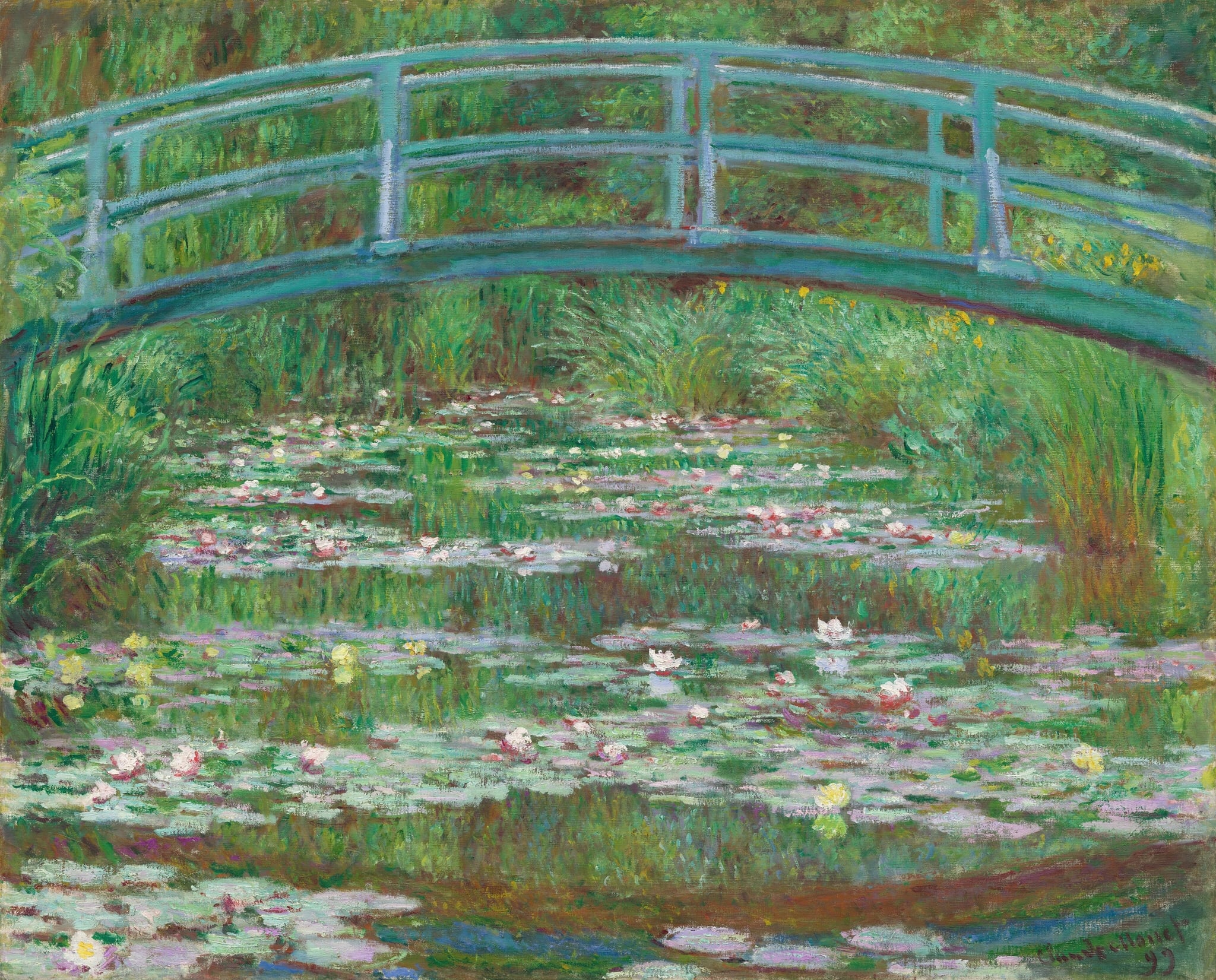
The Japanese Footbridge
Claude Monet (1899)
Claude Monet’s The Japanese Footbridge turns his Giverny garden into an <strong>immersive field of perception</strong>: a pale blue-green arc spans water crowded with lilies, while grasses and willows dissolve into vibrating greens. By eliminating the sky and anchoring the scene with the bridge, Monet makes <strong>reflection, passage, and time</strong> the picture’s true subjects <sup>[1]</sup><sup>[2]</sup>.
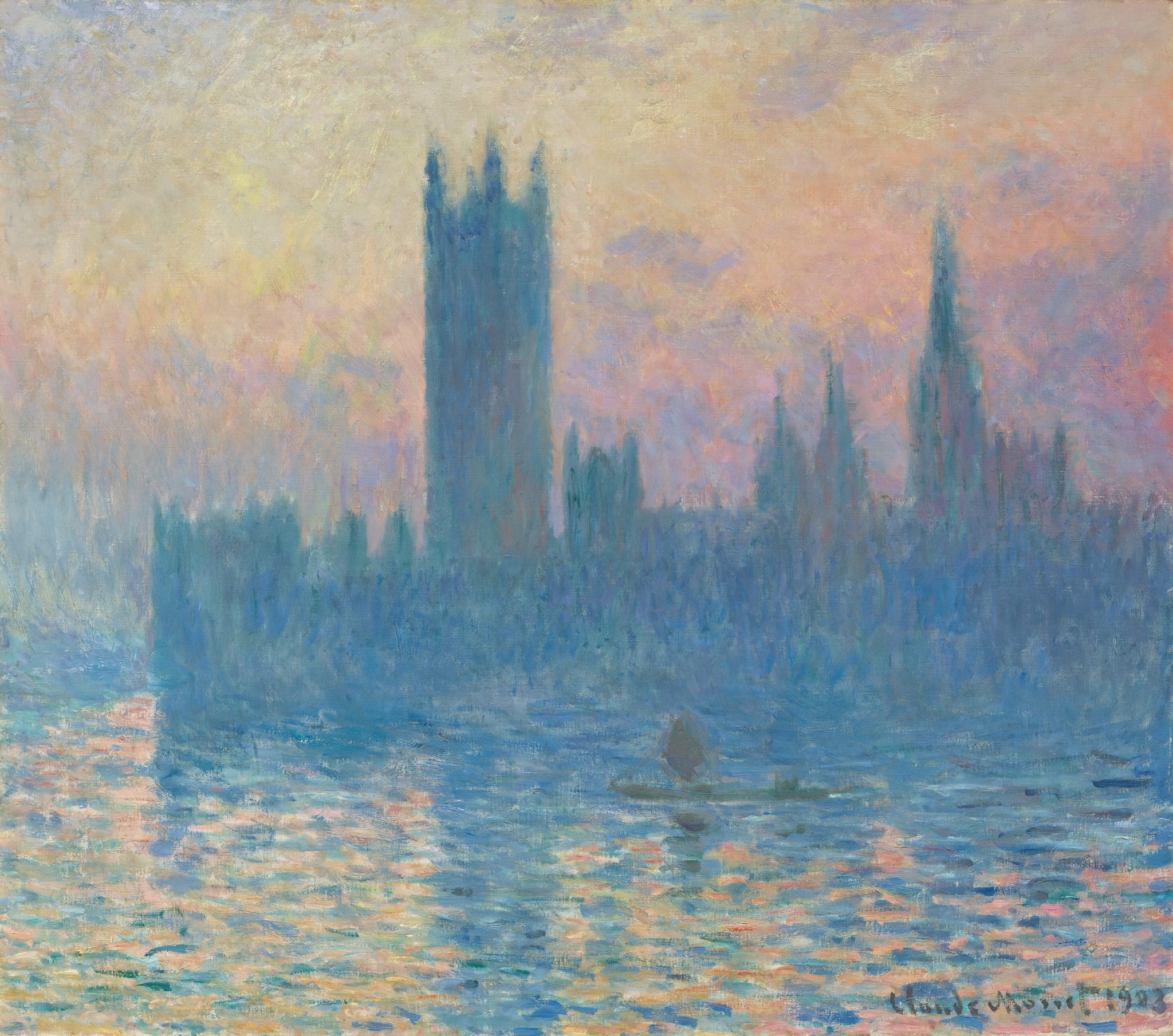
Houses of Parliament
Claude Monet (1903)
Claude Monet’s Houses of Parliament renders Westminster as a <strong>dissolving silhouette</strong> in a wash of peach, mauve, and pale gold, where stone and river are leveled by <strong>luminous fog</strong>. Short, vibrating strokes turn architecture into <strong>atmosphere</strong>, while a tiny boat anchors human scale amid the monumental scene.
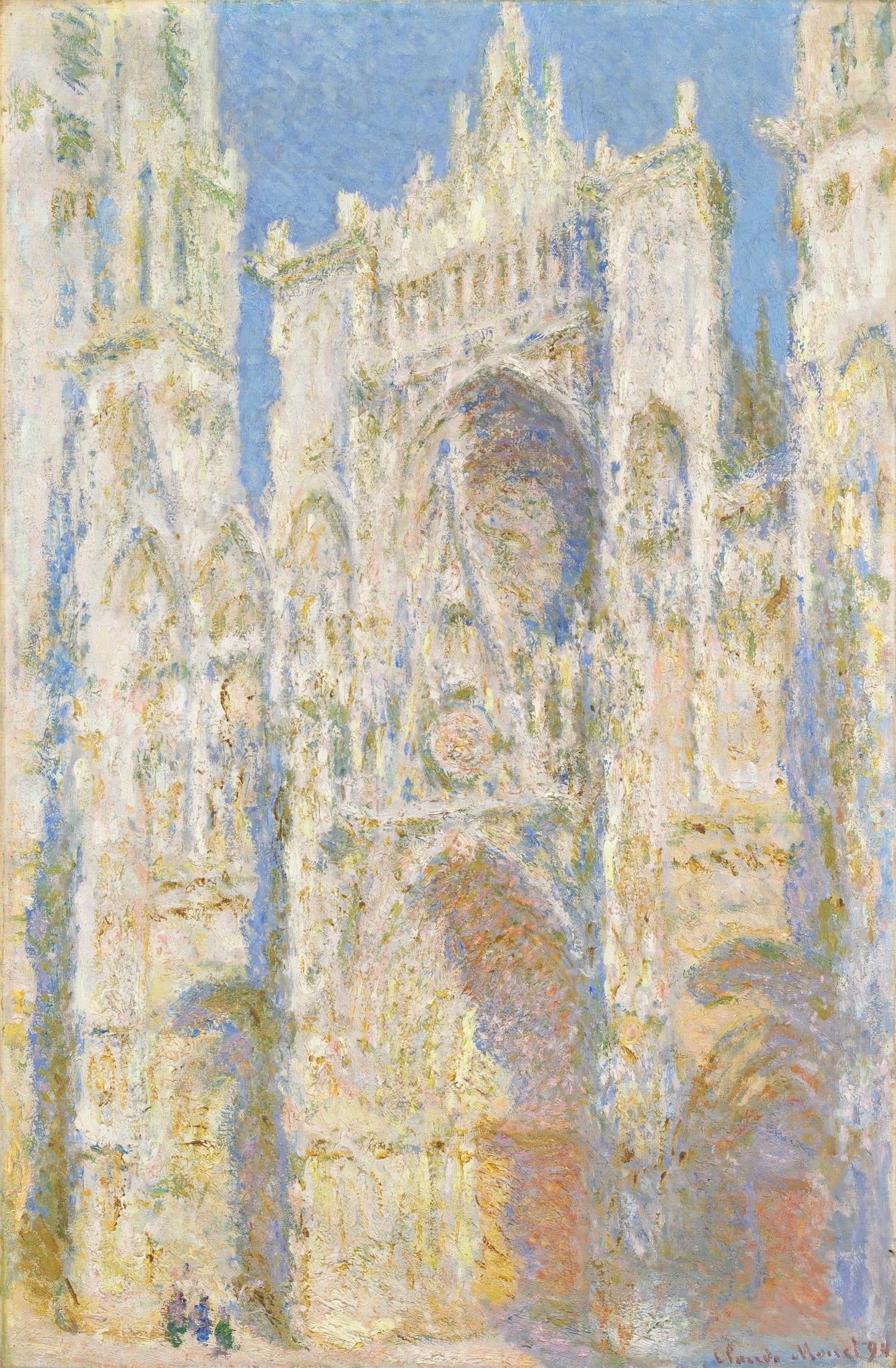
Rouen Cathedral Series
Claude Monet (1894)
Claude Monet’s Rouen Cathedral Series (1892–94) turns a Gothic monument into a laboratory of <strong>light, time, and perception</strong>. In this sunstruck façade, portals, gables, and a warm, orange-tinged rose window flicker in pearly violets and buttery yellows against a crystalline blue sky, while tiny figures at the base anchor the scale. The painting insists that <strong>light—not stone—is the true subject</strong> <sup>[1]</sup><sup>[2]</sup>.